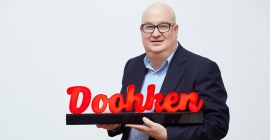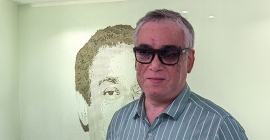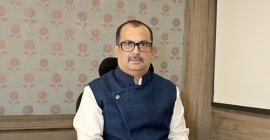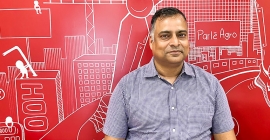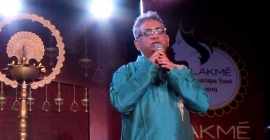“Interactive technologies can bring alive OOH essence”: Thapas Joseph
By Bhawana Anand & Pray Jani - October 21, 2019
Thapas Joseph, President of Fountainhead Digital MKTG talks about the myriad OOH opportunities that will be come by with the use of extended technologies. Edited excerpts
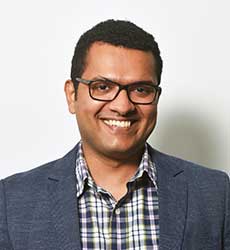 AR, VR technology has been in the market from quite some time but it has picked up only recently. Why has it taken this long?
AR, VR technology has been in the market from quite some time but it has picked up only recently. Why has it taken this long?
There are three technologies in extended reality i.e. Augmented Reality, Virtual Reality and Mixed Reality and the oldest is Virtual Reality because principally VR started with games where the user gets immersed in a space. AR started much later that essentially needed to have a lens to view the content and it started with the smartphone revolution. And third MR, is when both AR & VR come together. So in essence AR is about augmenting your space, VR is about being immersed completely in a virtual environment and MR is a combination of both.
It took time because there were some hurdles in ensuring that these technologies can deliver an optimal user experience. For instance, in the case of AR, the challenge is that it is requires one to download an app to make it work. That is, for any marketing campaign, you need to download an app which would also mean heavy graphics and heavy files. Therefore, the process of getting the user to experience wasn’t seamless. However, recently when Apple and Google started to promote technology a real change has come about in it use. Likewise, Amazon has come into the VR space. Indeed, it has really made the change. Till now these technologies were giving interrupted experience where you need to browse or experience with wearables but now Google and Apple are intending to provide this experience via smartphones. Currently we are on the cusp of this change.
VR is primarily a gaming experience for entertainment and educational purpose; the problem with VR has been that the user has to wear quirky headsets which also entails a whole set of issues. Also, as consumers are used to experience very high definition content in 4K & 8K and VR at this level only offer an HD level of resolution, it is not really the best kind of experience. There are hardware and technical issues that are preventing its growth. However, there are some interesting developments taking place on the hardware front where headsets are becoming less heavy and there are case where VR can be experienced without having to wear them.
Any technology revolution is actually a result of different fields of research that suddenly reach a convergence. Now we are at a stage where it is completely going to change the usage of the internet because it allows us to do some much more. For instance, today, a QR code reader isn’t required to read one. Likewise, a user will not have to type and search, one just needs to point a camera to know everything about the product/service and its related offers, discounts, etc.
How would these technologies amplify the brand experience in the OOH space?
In the OOH context, it could be considered a threat. For instance, if a user has to wear a wearable to determine what they see, then is there really the need for hoardings or posters or large displays. That’s one way to look at it. The second way to look at it is, with these smart devices a lot can be done in terms of hyper-personalising on what people see on hoarding or display.
In fact, the Dentsu group is working with technology partners internationally where a hoarding can sense a car passing by and personalise the advertisement according to that. There is a huge opportunity for outdoor in this regard. Technologies like VR, AR and MR can make OOH smarter, measurable, interactive and immersive.
How can the advertising, media & marketing agency is going to convince brands to bet their money on extended technologies?
In terms of metrics and measurement, brands will automatically start getting engagement, immersion and time spent data. Larger brands would find it easier to adopt this as opposed to smaller brands whose media mix just comprise outdoor, retail or just digital. It requires a significant amount of capital so the saving is when you look at the entire marketing mix.
The media and advertising industry also need to educate the clients on extended technologies. The conversations that the outdoor industry would need to have about these technologies are going to be different. Great work happens where there is a push from both sides, so it requires great clients and agencies to come into the picture.
The Burger King’s Burn campaign is one of the best examples of AR on OOH. We did a VR activity for Mondelez for Oreo Chocolate and one onground corporate park activation for Van Heusen in Bengaluru. In this we used motion sensing and interactivity technologies where the display came alive.
How best can OOH industry leverage this technology?
The technology exists. It is now a capital investment process that has get underway. The solutions are available in the cloud.
In OOH, probably static displays would need to be converted to digital screens and go digital or phygital. In fact, there is a huge possibility of doing this even without digital technology. For instance, we have done an experiment where an array of light responds to human body movement. And this brings us to another domain -- Internet of Things. All these are opening up different possibilities, ranging from creative to metrics.
Do you think the Indian market is ready for these interactive, extended technologies?
Absolutely! In fact, we Indians have the tendency to leapfrog. Our ecommerce industry jumped from desktop to smartphones. India is a very big potential market from the ecommerce side since it is a digital savvy market and at the same time, we are very traditional buyers. We like to see how things look. I think we are ready for it but it requires small modifications in the technology.
It will be up to the brands to see the value and for the agencies to be able to answer the questions coming from the marketing managers, such as, on measurability, etc. The best thing is whether it is innovative outdoor or AR, VR, etc., they can be connected back to a system to get the metrics. I think we are just a couple of months away from witnessing some good work in this area.
What are the likely challenges in using these technologies in the OOH space?
The first challenge is the apprehension/fear that users have about any innovative technology. It is part of our industry and we have to convince brands to buy and experiment with it. In many cases, we come across clients who don’t even know the difference between AR, VR, and MR. But the good part is we see some good work happening in the Indian market and once we can demonstrate the measurability and the ease of use of these technologies and the value addition, that will bring about the mindset shift.
Agencies are going to have to learn the way to demonstrate these technologies. We have set up our experiential lab where we do the R&D. Where other agencies pitch using PPTs we pitch using a proof of concept drawn from our experiential labs where we are able to make viable product in 15 days and we get the client experience it.
For more updates, subscribe to media4growth newsletter - Click here

Stay on top of OOH media trends

